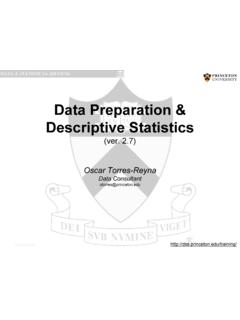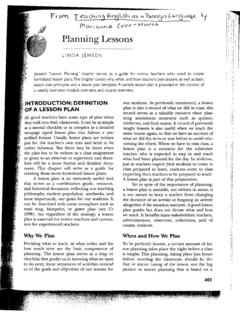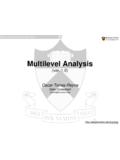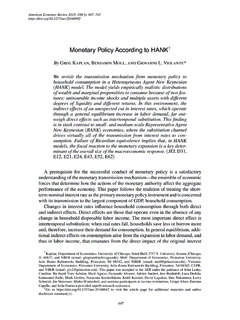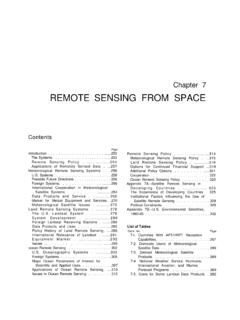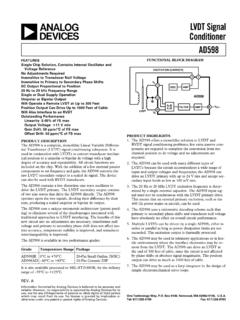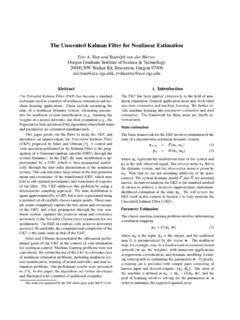Transcription of Lecture 8 Properties of the Fourier Transform
1 Lecture 8 ELE 301: Signals and SystemsProf. Paul CuffPrinceton UniversityFall 2011-12 Cuff ( Lecture 7)ELE 301: Signals and SystemsFall 2011-121 / 37 Properties of the Fourier TransformProperties of the Fourier TransformILinearityITime-shiftITime ScalingIConjugationIDualityIParsevalConv olution and ModulationPeriodic SignalsConstant-Coefficient Differential EquationsCuff ( Lecture 7)ELE 301: Signals and SystemsFall 2011-122 / 37 LinearityLinear combination of two signalsx1(t) andx2(t) is a signal of the formax1(t) +bx2(t).
2 Linearity Theorem:The Fourier Transform is linear; that is, given twosignalsx1(t) andx2(t) and two complex numbersaandb, thenax1(t) +bx2(t) aX1(j ) +bX2(j ).This follows from linearity of integrals: (ax1(t) +bx2(t))e j2 ftdt=a x1(t)e j2 ftdt+b x2(t)e j2 ftdt=aX1(f) +bX2(f)Cuff ( Lecture 7)ELE 301: Signals and SystemsFall 2011-123 / 37 Finite SumsThis easily extends to finite combinations. Given signalsxk(t) with FouriertransformsXk(f) and complex constantsak,k= 1,2,..K, thenK k=1akxk(t) K k=1akXk(f).If you consider a system which has a signalx(t) as its input and theFourier transformX(f) as its output, the system is linear!
3 Cuff ( Lecture 7)ELE 301: Signals and SystemsFall 2011-124 / 37 Linearity ExampleFind the Fourier Transform of the signalx(t) ={1212 |t|<11|t| 12 This signal can be recognized asx(t) =12rect(t2)+12rect(t)and hence from linearity we haveX(f) =(12)2sinc(2f) +12sinc(f) =sinc(2f) +12sinc(f)Cuff ( Lecture 7)ELE 301: Signals and SystemsFall 2011-125 / 37! !2! !1! ! !10!8!6!4!20246810! 2 102 2 4 4 sinc( / )+12sinc( /(2 ))12rect(t/2)+12rect(t)Linearity ExampleCuff ( Lecture 7)ELE 301: Signals and SystemsFall 2011-126 / 37 Scaling TheoremStretch (Scaling) Theorem: Given a Transform pairx(t) X(f), and areal-valued nonzero constanta,x(at) 1|a|X(fa)Proof:Here consider onlya>0.}
4 (negativealeft as an exercise) Changevariables =at x(at)e j2 ftdt= x( )e j2 f /ad a=1aX(fa).Ifa= 1 time reversal theorem: X( t) X( f)Cuff ( Lecture 7)ELE 301: Signals and SystemsFall 2011-127 / 37 Scaling ExamplesWe have already seen thatrect(t/T) Tsinc(Tf) by brute forceintegration. The scaling theorem provides a shortcut proof given thesimpler resultrect(t) sinc(f).This is a good point to illustrate a property of Transform pairs. Considerthis Fourier Transform pair for a smallTand largeT, sayT= 1 andT= 5. The resulting Transform pairs are shown below to a commonhorizontal scale:Cuff ( Lecture 7)ELE 301: Signals and SystemsFall 2011-128 / 37 Compress in time - Expand in frequency!
5 20!1001020! !20!1001020! !10!50510!20246!10!50510!2!1012345 5 10 05 10 5 10 05 10 0 55 10100 55 1010ttsinc( /2 )5sinc(5 /2 )rect(t)rect(t/5)Narrower pulse means higher ( Lecture 7)ELE 301: Signals and SystemsFall 2011-129 / 37 Scaling Example 2As another example, find the Transform of the time-reversed exponentialx(t) =eatu( t).This is the exponential signaly(t) =e atu(t) with time scaled by -1, sothe Fourier Transform isX(f) =Y( f) =1a j2 ( Lecture 7)ELE 301: Signals and SystemsFall 2011-1210 / 37 Scaling Example 3As a final example which brings two Fourier theorems into use, find thetransform ofx(t) =e a|t|.
6 This signal can be written ase atu(t) +eatu( t). Linearity andtime-reversal yieldX(f) =1a+j2 f+1a j2 f=2aa2 (j2 f)2=2aa2+ (2 f)2 Much easier than direct integration!Cuff ( Lecture 7)ELE 301: Signals and SystemsFall 2011-1211 / 37 Complex Conjugation TheoremComplex Conjugation Theorem:Ifx(t) X(f), thenx (t) X ( f)Proof:The Fourier Transform ofx (t) is x (t)e j2 ftdt=( x(t)ej2 ftdt) =( x(t)e ( j2 f)tdt) =X ( f)Cuff ( Lecture 7)ELE 301: Signals and SystemsFall 2011-1212 / 37 Duality TheoremWe discussed duality in a previous Theorem:Ifx(t) X(f), thenX(t) x( f).
7 This result effectively gives us two Transform pairs for every Transform signalx(t) has a Fourier transforme |f|?Cuff ( Lecture 7)ELE 301: Signals and SystemsFall 2011-1213 / 37 Shift TheoremThe Shift Theorem:x(t ) e j2 f X(f)Proof:Cuff ( Lecture 7)ELE 301: Signals and SystemsFall 2011-1214 / 37 Example: square pulseConsider a causal square pulsep(t) = 1 fort [0,T) and 0 can write this asp(t) =rect(t T2T)From shift and scaling theoremsP(f) =Te j fTsinc(Tf).Cuff ( Lecture 7)ELE 301: Signals and SystemsFall 2011-1215 / 37 The Derivative TheoremThe Derivative Theorem:Given a signalx(t) that is differentiable almosteverywhere with Fourier transformX(f),x (t) j2 fX(f)Similarly, ifx(t) isntimes differentiable, thendnx(t)dtn (j2 f)nX(f)Cuff ( Lecture 7)ELE 301: Signals and SystemsFall 2011-1216 / 37 dual Derivative FormulaThere is a dual to the derivative theorem, , a result interchanging therole oftandf.]
8 Multiplying a signal bytis related to differentiating thespectrum with respect tof.( j2 t)x(t) X (f)Cuff ( Lecture 7)ELE 301: Signals and SystemsFall 2011-1217 / 37 The Integral TheoremRecall that we can represent integration by a convolution with a unit step t x( )d = (x u)(t).Using the Fourier Transform of the unit step function we can solve for theFourier Transform of the integral using the convolution theorem,F[ t x( )d ]=F[x(t)]F[u(t)]=X(f)(12 (f) +1j2 f)=X(0)2 (f) +X(f)j2 ( Lecture 7)ELE 301: Signals and SystemsFall 2011-1218 / 37 Fourier Transform of the Unit Step FunctionHow do we know the derivative of the unit step function?
9 The unit step function does not converge under the Fourier just as we use the delta function to accommodate periodic signals, wecan handle the unit step function with some the approximation thatu(t) e atu(t) for ( Lecture 7)ELE 301: Signals and SystemsFall 2011-1219 / 37A symmetric construction for approximatingu(t)Example:Find the Fourier Transform of the signum or sign signalf(t) = sgn(t) = 1t>00t= 0 1t< can approximatef(t) by the signalfa(t) =e atu(t) eatu( t)asa ( Lecture 7)ELE 301: Signals and SystemsFall 2011-1220 / 37 This looks like!
10 2! !1! ! !1! te t/5sgn(t)Asa 0,fa(t) sgn(t).The Fourier Transform offa(t) isFa(f) =F[fa(t)]=F[e atu(t) eatu( t)]=F[e atu(t)] F[eatu( t)]=1a+j2 f 1a j2 f= j4 fa2+ (2 f)2 Cuff ( Lecture 7)ELE 301: Signals and SystemsFall 2011-1221 / 37 Therefore,lima 0Fa(f) =lima 0 j4 fa2+ (2 f)2= j4 f(2 f)2=1j suggests wedefinethe Fourier Transform of sgn(t) assgn(t) {2j2 ff6= 00f= ( Lecture 7)ELE 301: Signals and SystemsFall 2011-1222 / 37 With this, we can find the Fourier Transform of the unit step,u(t) =12+12sgn(t)as can be seen from the plotst01 1t01 1sgn(t)u(t)The Fourier Transform of the unit step is thenF[u(t)] =F[12+12sgn(t)]=12 (f) +12(1j f).}
